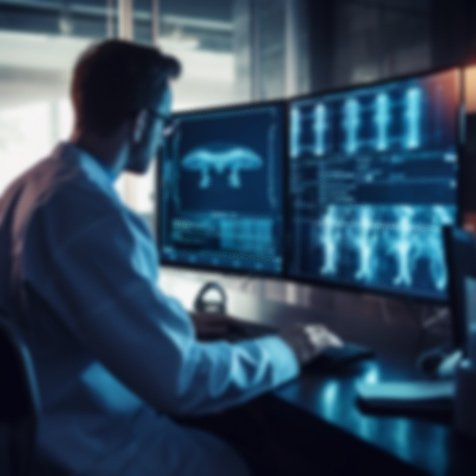AI-Powered Patient Data Analysis
AI-Powered Patient Data Analysis
Introducing IX Innovation's
Patent 11,357,582
Welcome to the future of surgical technology, where the power of artificial intelligence and robotics is harnessed to enhance patient care and surgical outcomes. Patent 11,357,582 emphasis on machine learning and robotics aligns with the industry's shift towards AI-powered solutions and the system's compatibility with a range of processing capabilities, from consumer-grade computers to quantum computers, ensures its relevance in the face of technological advancements. This opens up possibilities for more precise surgeries, quicker diagnoses, and more efficient patient care. It is a prized asset for medical device startups, mid-size companies, and large corporations alike, offering numerous benefits that make it key for shaping the future of robotic surgical technologies leveraging artificial intelligence.

Introducing IX Innovation's Patent
11,357,582
System For Transcribing And Performing Analysis On Patient Data
Patent Claims
This patent introduces an advanced system that leverages machine learning and robotics to transcribe and analyze patient data. It collects data from medical professionals, sensors, and imaging devices, performs an analysis, and presents the data to medical professionals in a conversational manner. This allows for additional data input, such as observations or instructions, which can be used for further analysis or to perform actions related to the patient's care.
WHY IS THIS PATENT
VALUABLE?
As robotic surgery improves, this patent paves a way for advanced medical devices that can improve patient outcomes, reduce errors, and increase efficiency
Automated and Robotic Surgical Procedures:
The patent proposes a system for transcribing and performing analysis on patient data, which can be used in automated and robotic surgical procedures. This can improve the precision and efficiency of these procedures.
Communication and Coordination
The system can improve communication and coordination among the surgical team, care providers, patients, and their families. This can help prevent surgical errors and adverse events during surgery.
Efficiency
The system can decrease the amount of time needed for a surgeon or other medical professional to review patient data. This can make medical professionals more efficient and allow them to address the needs of more patients in the same amount of time.
Precision in Surgery
The system can enable more accurate surgery in minute locations on or within the human body. This can improve the outcomes of surgical procedures.
Integration with Existing Technologies
The system can be integrated with existing technologies, such as vital signs monitors, heart rate monitors, pulse oximeters, end-tidal CO2 monitors, blood pressure monitors, body temperature monitors, respiration rate monitors, electrocardiogram monitors, neuromonitors, motor evoked potential monitors, somatosensory evoked potential monitors, electromyography monitors, and electroencephalography monitors. This can enhance the functionality and utility of these technologies.
Patient Safety
The system can help reduce the rate of adverse events during surgical procedures, which remains high despite traditional patient safety initiatives. This can significantly improve patient safety.
Data Analysis
The system can perform analysis on patient data and present the data to a medical professional in a conversational manner. This can help the medical professional make more informed decisions and provide better patient care.
Cost Reduction
The system can make medical procedures safer and less costly for patients. This can make healthcare more accessible and affordable.
Why you should invest in IXI Patent
11,357,582?
Investing in Patent 11,357,582 supports the future of human surgery particularly in the artificial intelligence, machine learning, and patient data
-
For startups, it offers a competitive edge by providing a unique, innovative solution that addresses a critical need in the medical industry. It can serve as a foundation for developing a range of products and services, from surgical devices to healthcare software solutions.
-
Mid-size companies can leverage this patent to expand their product portfolio and enter new markets. It provides an opportunity to differentiate their offerings and establish themselves as leaders in the field of medical technology.
-
For large corporations, this patent can enhance their existing product line, drive innovation, and maintain their market leadership. It can also help them meet regulatory requirements and adhere to best practice guidelines for performing surgery.

